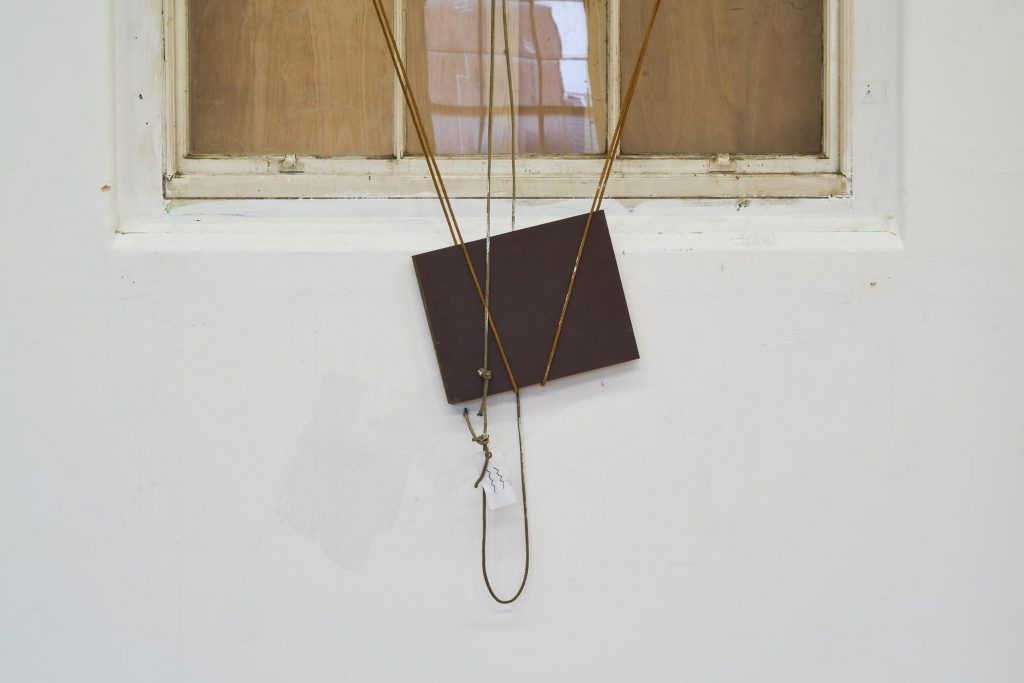
“I just walk around and bump into things,” says Abbas Zahedi via Zoom about the healthy level of ignorance that keeps his relationship to his art practice grounded and organic. “For me, art is up there in terms of importance, but for most people Nando’s is probably more important, and there’s nothing wrong with that.” The London-based artist’s solo show, Ouranophobia SW3 (meaning ‘fear of heaven’) opened at the end of last year in the old Chelsea Sorting Office, where he undercut the authoritarian nature of this late-Victorian building. Here, a staircase was constructed to climb the ground-floor hall and look through the raised windows. Downstairs, a darkened canteen was made into a sanctuary with spiritual poetry mixed into an electronic soundscape, sampled from New York duo Saint Abdullah. While the exhibition had to close prematurely due to lockdown restrictions, the artist re-presented the site with a group of neurologists called Neurofringe; enabling frontline workers and NHS staff to find therapeutic respite amidst Zahedi’s work as part of their Sonic Support Group collaboration, which uses art’s capacity for self-exploration to alleviate daily pressures. “You do not need to know what the lamentation prayer is saying,” Zahedi explains, “you go into that space in an embodied way, allowing you to feel what needs to be felt.”
The artist’s minimalist style was also evident in his earlier How to Make a How from a Why? exhibition at the South London Gallery, which ran from March 6 to September 13, 2020. The central piece was a sprinkler system filled with rosewater, referencing the drink offerings his family would prepare to commemorate the passing of saints, as well as the sacred role that the particular liquid has in Iranian burial rites. This intersection of the social and the sacred is something imbued with a diasporic, working class narrative, but one that constantly errs towards abstraction.

Zahedi himself is going against the representational model, instead building on his many years of community work where he tries to generate distance from our common reality; places to reflect, inspect, investigate or expand: “[Because of the] fact that I have interest in materials, in sound, in spatiality, I am able to articulate that experience in a physical sense,” he says about creating these spaces of thoughtfulness and contemplation littered with poetic, spiritual and social allusions. “So when other people inhabit the space, they feel it too. It’s present. It works. I don’t take it for granted that that’s going to be the result. Every time I do something, I feel it’s a risk, especially on an emotional level. In this case, it has also been a risk because the show closed down after so little time. I’m grateful for being able to re-present the work now to those working on the frontlines.”
**I am interested in your use of poetry as an artist, particularly as you have a background as an emcee. A lot of my background is in poetry, and I’m always interested in how people are using that idea of poetics, deploying that idea in artistic practices. I get the feeling from a lot of your work that it’s grounded in something social, but also something specifically artistic. I’m wondering how you’re seeing poetics in that frame.
Abbas Zahedi: I suffer from this quality where I find it really hard to separate things out into neat categories. At first, I used to think it was because I lacked focus or lacked discipline, but then, from reading more, and being more interested in contemporary ways of thinking I came to a different understanding.
One of the things I did early on, back when I was doing community work, was to set up a philosophy symposium at my local fish and chip shop. At first it was informal, but then we started taking it so seriously that it became a formative process. The customers used to get involved, different people would come on board and the thing just spread. I was studying medicine at the time and felt this was a really good outlet to have as another way of thinking. Then I saw that there was a lot of crossover in terms of philosophy, science, literature and art, and this encouraged me to be a bit more promiscuous with ideas.
**You’re always trying to undo those categories. When I write about art, you need them to guide people. I guess when you’re producing something, it’s different. I managed to get to your current exhibition Ouranophobia SW3 before it was closed. What I liked about it was you weren’t telling people what was going on. You had to guide your own way intuitively, and when you get to the downstairs bar with the soundscape playing, it’s a place you want to stay. You want to sit there for a while, and just linger. In your work you’re trying to make us linger and think, almost before the concepts, is that correct?
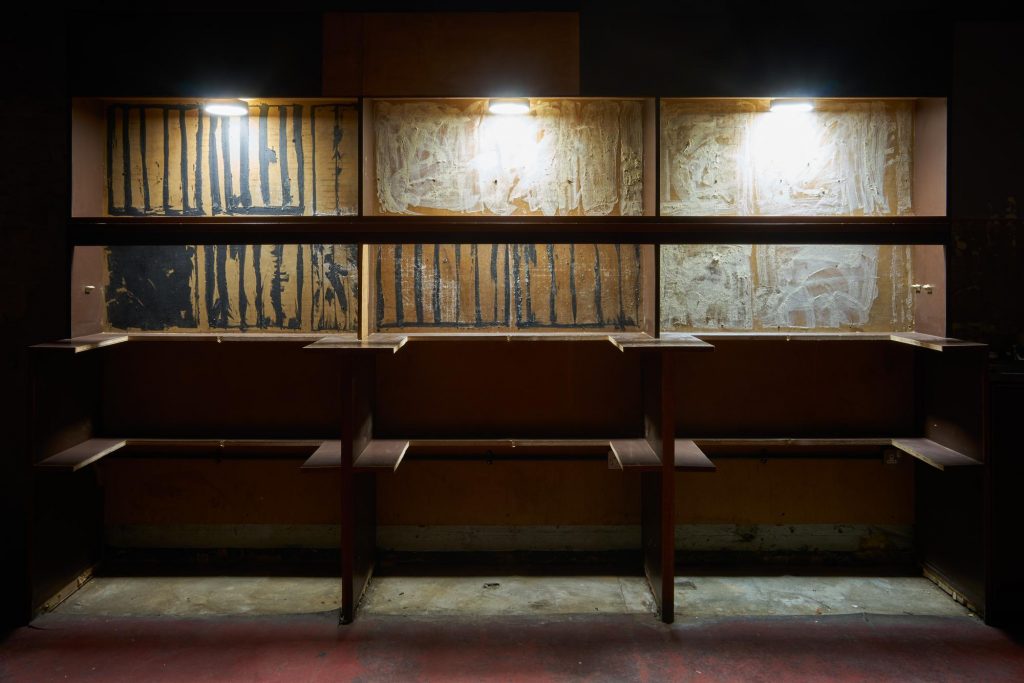
AZ: Yes, definitely. I have this fascination with phenomenology and how my work can help to re-embody the art experience. I was speaking to the artist Joshua Leon about this, and he described it as a process of making a spectator into a visitor, and then a guest—I really relate to that. I’m always guided by wanting attention to be given to the experience of this guest figure, and relate that to something already present in the space. This show is called Ouranophobia, which means fear of heaven or the sky.
When I entered the Chelsea Sorting Office, I really felt like that the space was created to dominate whoever stands in the main hall, like a prison or a church, something which is trying to impose itself with a sense of authority. I felt this whole place is created to manifest a sense of surveillance and control, dictated by sightlines that occupy the different vertical levels: This idea of a surveillance system, rooted in utilitarianism, made manifest via a panopticon style of architecture. I became compelled to look into that and the surrounding histories, and to think what would be an interesting intervention that could poetically inhabit or lay that logic to rest.
**In a lot of contemporary art discourse, or culture in general, we are connecting our everyday social activity with deeper ideas. A lot of people are going to sacred ideas or devotional ideas—certainly people with migrant backgrounds—and we could put that down to multiple contemporary crises. The way that you’re talking, it sounds like you don’t even want to go there, you don’t even want to touch that. I am wondering how you are navigating your work within an art world that wants you to go there, to talk about and situate these ideas.
AZ: The short answer is just using a lot of layers. If someone really wants that, it’s in the work, you can see it. It’s my experience too. I came from a reality where I’m very familiar with that way of understanding of the world. At the same time, I have developed other systems of cosmology, epistemology, all kinds of sense-making philosophies. The reason I’m reluctant to lean too heavily into this sacred, spiritual thing is because I really did that—I really come from a place of having sincere devotion to enchanted worldviews that were quite conservative and expressive at times, so it’s not just about it being a vibe.

Growing up, I was the generation who were in their late teens, post-9/11. We were the first ones getting radicalised and I saw a lot of people fall into that. That whole discourse of Clash of the Civilizations’ by [Samuel P.] Huntington was a reality for us. Doing the fish and chip shop symposium really came out of that predicament, where my friends and I who were also from similar backgrounds—Egyptian, Turkish, Somali—came up in this immigrant context. Now we’re at university studying science and wondering what the hell is going on. The provincial, superstitious type of religiosity that we had inherited from our parents’ generation started to unravel. We were not only reading Western philosophy, we went deep into Theosophy and the various crevices of Islamic thought—Kalam and the Ash’aris. We were really active in trying to understand our inherited belief systems within a modern context, to reach some sort of feeling, something we could call contemporary.
What I sometimes see prevailing now is a more nostalgic form of religiosity, it feels more primal, kind of like the Gaia stuff, trying to go back to something way more ‘source-level’. I feel like I have gone in a different, and yet still sympathetic, direction. Even if it’s not as trendy, I resonate more with what I call a Deleuzian approach to materialism, that comes out of the mathematics of the early 20th Century. That whole discourse was about how there’s sufficient complexity present in the earth, and in the bodies that we inhabit; that we can relate to those features as our metaphysics without resorting to transcendence or essentialism. To me, that was very eye-opening. I thought to myself, ‘this is exactly what the mystical poets of the Islamic tradition, especially the Persian, ones were also saying. It’s more ‘meta’-modern than post.
My intention in presenting an art installation is to make you pay attention to what is both in front and inside of you, and try to extract as much sense-making and understanding [as possible] from that sense of embodiment. Like an experience that bypasses the thinking part of your brain and goes somewhere more sensual, while at the same time making sure I don’t just end up repackaging my version of mysticism for an art audience. To me that’s not art, that’s more in the line of ethnography.
**There are two follow-ups to your answer I want to ask you: One, does that relate to your idea of ‘neo-diaspora’, and two, in Ouranophobia, and at the South London Gallery show, there’s a minimalism, while still being embedded with allusions and references. Are those things related for you, and to your ideas you’ve detailed regarding art, philosophy and the sacred?
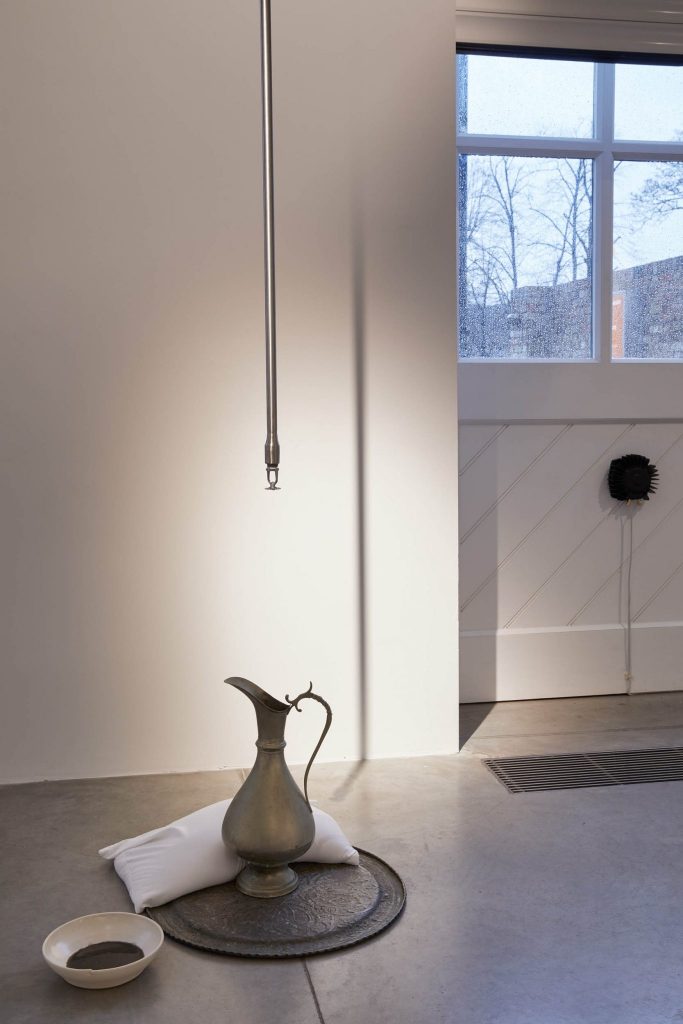
AZ: The way I see the relationship is more in terms of approach as opposed to their content. For example, ‘neo-diaspora’ was something that I could use as an anti-label. It was more like a place-holder and a schizoid maneuvering tool that I could navigate with and not necessarily have to commit to. [It was] a way of resisting all those other labels, philosophies or agendas that were being placed upon me at the time. I just remember using [neo-diaspora] as a way of shifting someone’s perspective as to what I’m doing. That’s the thing that helped me go to the Venice Biennale in 2017, for my first proper exhibition, so it definitely had an impact.
Just to be clear, I’m not so invested in minimalism from an aesthetic or art-historical perspective. The ones who made the canon have already completed the game on that front. When I am talking about my work in terms of minimalism, I understand it as a form that exists already and now it serves the purpose I am trying to seek in terms of a certain conversation or situation I am developing in my work. I will then go to that part of the canon, stretch it out, create this thing going sideways, and then actually talk about how it’s all related.
With neo-diaspora, I touched on the sensitive issue I was functioning from at that time, which was saturated with identity politics. In that case, minimalism became a way to work aesthetically, because it means I can go straight for the pressure point. Doing that one move affects a whole structure or discourse. Like in South London [Gallery], making a sprinkler system in that context was enough. The physicality of the piece is minimal but the experience is maximal, to the point that the viewer is the one who activates the pump to make the rosewater flow through the pipes. It’s multi-sensory: there’s smell, sound, it’s visual, it’s interactive and participatory. With very few objects I sought to create a whole world, an experience that addresses so many things. If you are just looking at it as a sculpture, then, yes it’s minimalist, but I don’t see it as a sculpture. I don’t even think I am working with objects; I work with people. That is what I always say. Even when I was doing the show in Chelsea [Ouranophobia], this was an issue I had with the curators. They thought it’s a sculpture show.
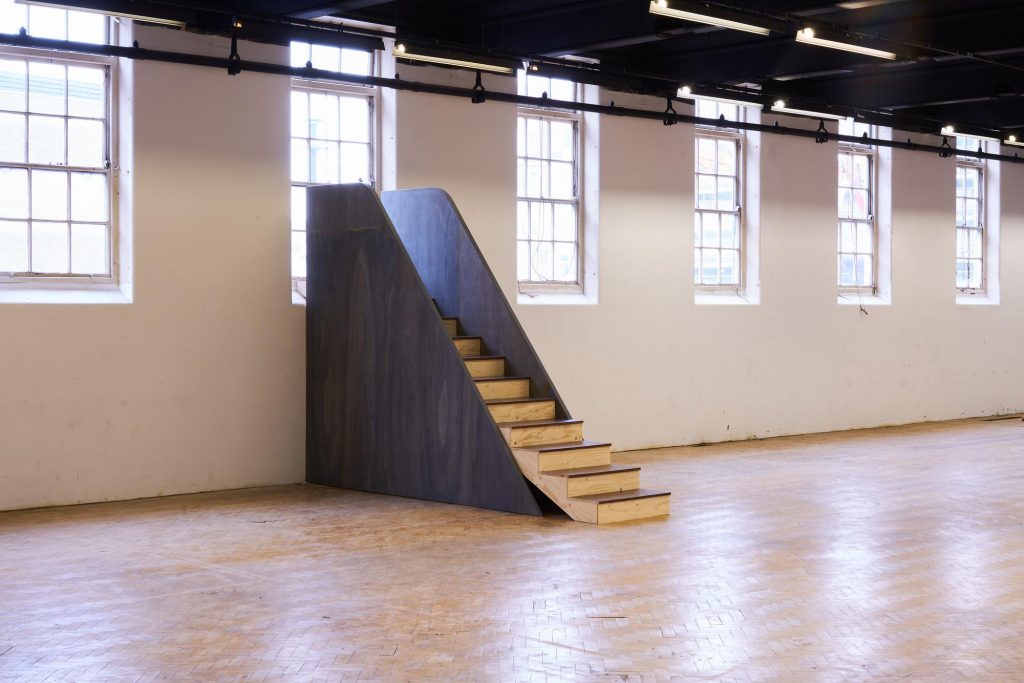
That is why I am grateful to have the chance to re-present the work for frontline staff now during lockdown, because this is not just an art space, it now has therapeutic potential due to the context in which it takes place. When I realised that there were these two distinct ways of looking at the work, I felt I had to do justice to this expanded approach. Something that was made evident to me when a group of neurologists called Neurofringe visited the show, and felt that the work could serve that purpose of support, especially for NHS staff. They were also interested in that interdisciplinary way that I work.
For example, downstairs where you have the prayer, it’s an Iranian prayer for the dead, which I sampled from the New-York based musicians Saint Abdullah. I then layered specific speech-patterns in there which I mixed into an electronic soundscape. These were of people who had suffered strokes who couldn’t talk anymore due to something called transductive aphasia. It means that the process of transduction is broken in terms of the language area of the brain. The process I am using to create those sounds via the wooden materiality of the bar in the basement uses surface transducers. These devices are actually recreating a similar process; a transduction mechanism which converts vibrational energy into sound. All these layers are related. The prayer for the dead is a voice recitation for the dead and the speech-patterns are in a way the voices of those who are now ‘braindead’, and this is all played out into the space via transduction—the building becomes a body.
**When you look at the living traditions of mass poetry in a place like India, and no doubt Iran, you come across a pantheon of figures such as Kabir, Guru Nanak, Mirabai, and Tagore. They are circulating language itself across heterogenous geographies. So Kabir is almost like a technology himself, as he mediates these different groups and their languages through the circulation of his poetry. Everything you have said has brought me back to that. So, when I am interested in the devotional it’s that social space I am interested in; I sense it is a similar place you are coming from?
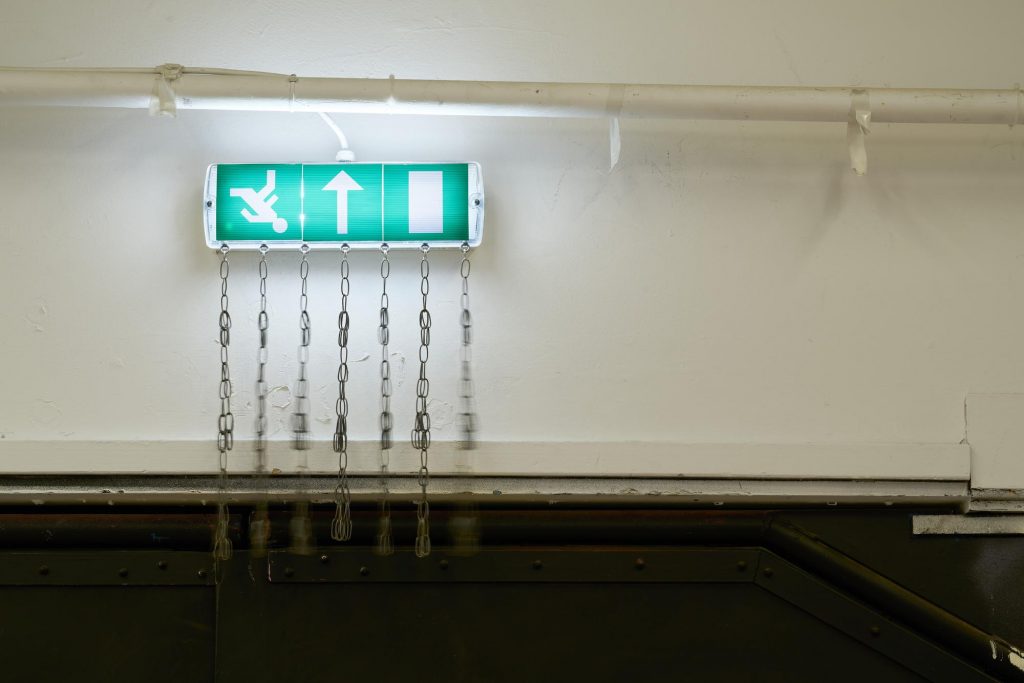
AZ: Yes, that’s a beautiful account and it brings it back to the experiential aspect. For example, poetry to me means those lamentation rituals, those grieving practices. I would be in a room full of a thousand middle-aged Iranian people in London somewhere, lights switched off, someone is reciting eulogies into the night and everyone is in tears. The closest I have ever come to recreating that feeling is in the basement in Chelsea as part of Ouranophobia. When I go there I am having a spiritual moment, but I don’t feel the need to lean into the representational aspects of those particular practices—it’s much closer to what you say, that idea that grief can become a technology.
With this approach, poetry can be understood as code-switching. As immigrant-spawn in London, we’re the ultimate code-switchers. My grandmother was unlettered, but she spoke the five or six different dialects and languages in her region. In all the family gatherings in Iran, she could speak to everyone in their own tongue. It’s similar to emcee-ing, poetry, spoken word. Now I understand I am doing something similar, but rather than switching languages and dialects, I’m switching experiential codes. My work has many layers: the poetic, the religious, the spiritual, philosophical, art-historical, the experiential, the participatory, the architectural. All these layers are in the work and they are consciously placed there. Depending on who is entering the space, they may access certain layers, they may access others. It is not like you have to know all of them for the work to work. It’s more of a dialogue, something more generous.**













